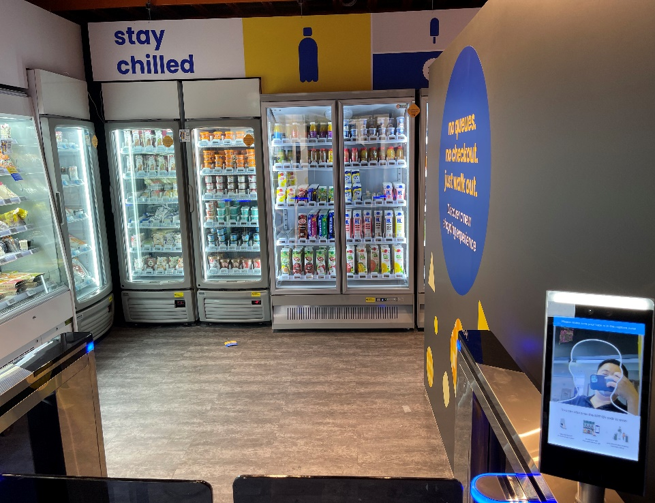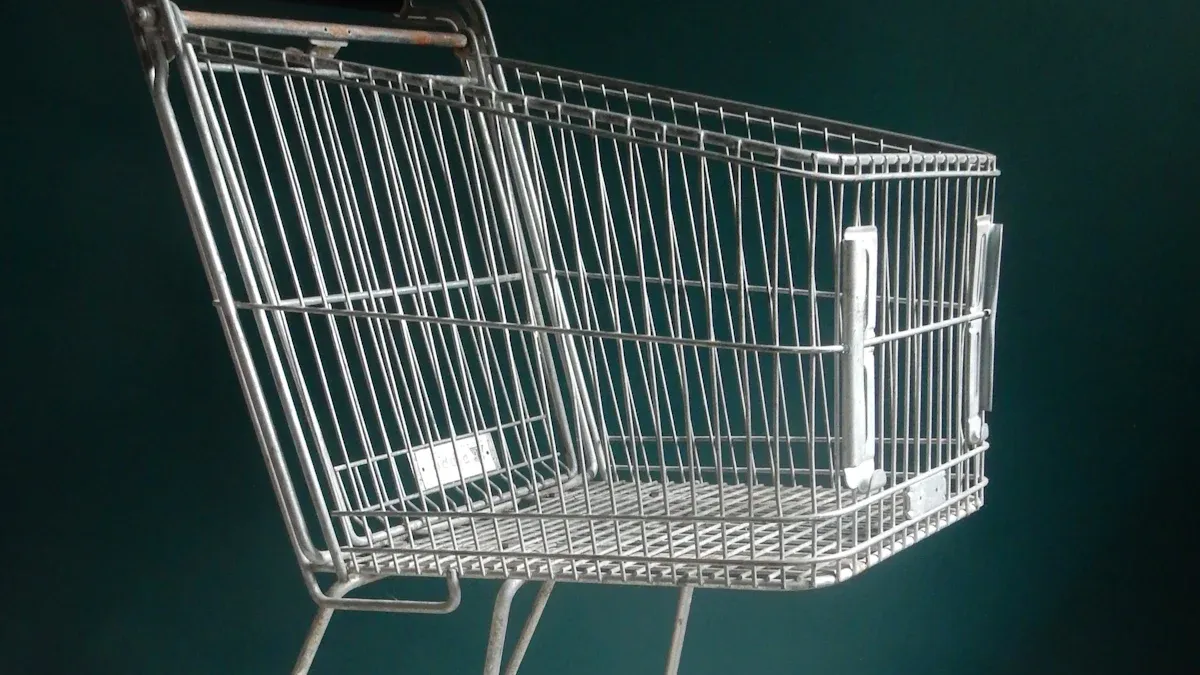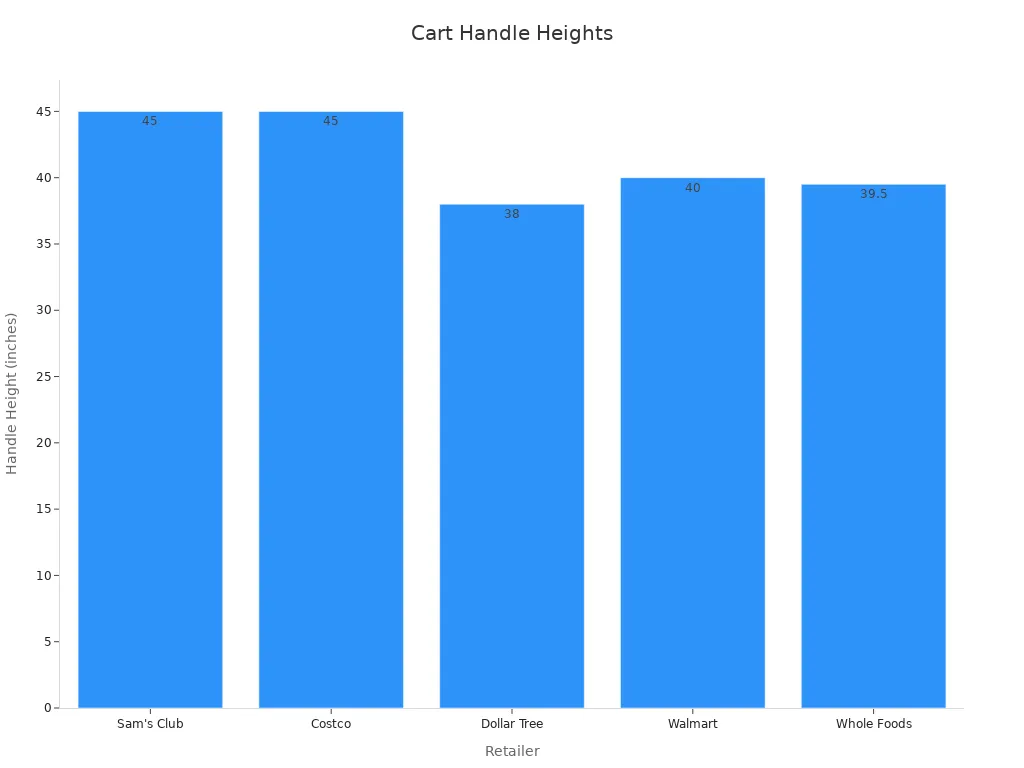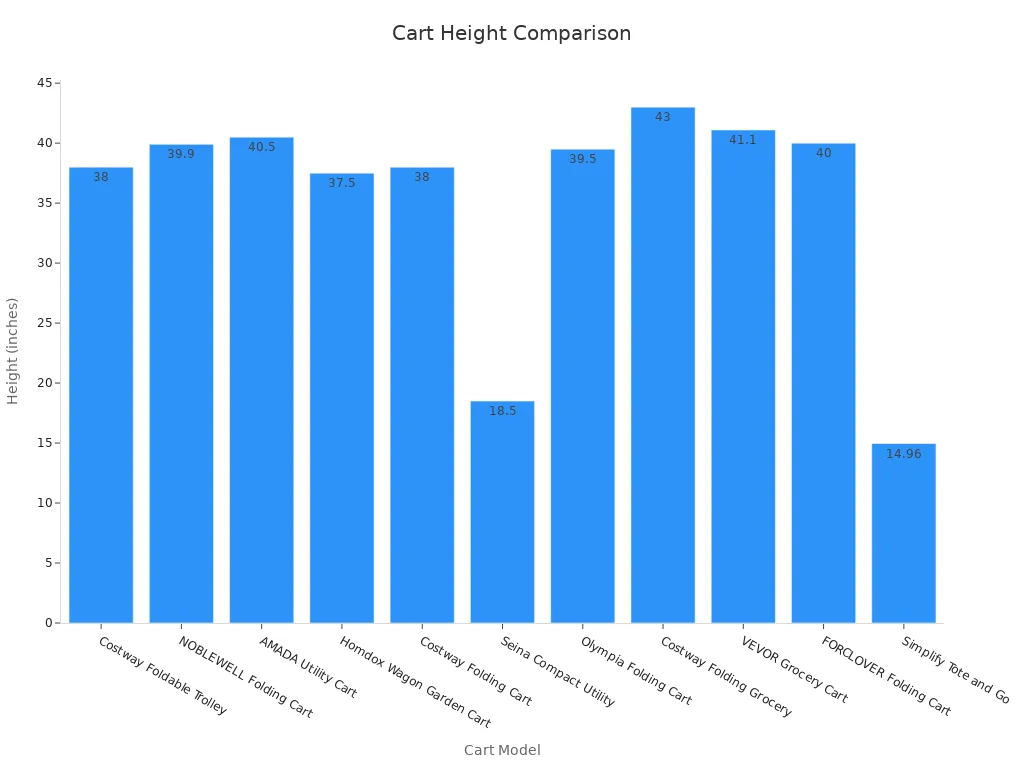Shopping Cart Dimensions and Size Specifications for Different Cart Types

You want to know the exact shopping cart dimensions before making a choice. Most stores use carts with these typical features:
Standard cart: 33–40 inches long, 20–25 inches wide, 35–42 inches high, 90–120 liters capacity
Compact cart: 25–30 inches long, 16–20 inches wide, 28–34 inches high, 50–70 liters capacity
Warehouse cart: 40–50 inches long, 24–28 inches wide, 38–44 inches high, 150–200 liters capacity
Industry guidelines recommend considering nesting distance, weight capacity, and accessible design. Always check if the cart meets safety and material standards. Choosing the right shopping cart dimensions helps match your store’s needs and keeps customers comfortable.
Key Takeaways
Shopping carts come in various sizes and types to fit different store layouts and customer needs.
Standard carts balance capacity and ease of use, while warehouse carts hold large bulk items and compact carts save space in small stores.
Choosing the right cart size improves customer comfort and store efficiency by matching aisle width, product types, and shopper preferences.
Plastic carts resist rust and weigh less, making them ideal for humid areas, while metal carts offer durability for heavy loads.
Regularly checking and maintaining carts ensures safety, extends their life, and keeps customers happy.
Shopping Cart Dimensions

When you choose a cart for your store, you need to know the exact shopping cart dimensions. Each type of cart fits a different retail environment and customer need. Below, you will find the most common sizes and features for each major cart type.
Standard Cart Sizes
Standard carts are the most common in grocery stores and supermarkets. They offer a balance between capacity and maneuverability. You can see their typical measurements and features in the table below:
Cart Type | Length (inches) | Width (inches) | Height (inches) | Volume (liters) | Handle Height (inches) | Notes |
|---|---|---|---|---|---|---|
Standard Grocery | 33–40 | 20–25 | 35–42 | 90–120 | 39.5–42 | Most common in supermarkets |
Target | N/A | N/A | N/A | N/A | N/A | Large child basket, cup holders |
Walmart | N/A | N/A | N/A | N/A | 40 | Comfortable for most adults |
Whole Foods | N/A | N/A | N/A | N/A | 39.5 | Ergonomic handle height |
Trader Joe’s | N/A | N/A | N/A | N/A | N/A | Smaller than average |
Note: Handle height matters for comfort. Most stores set the handle between 39 and 42 inches, which fits most shoppers.
You should also consider the basket’s shape. Most baskets have a trapezoidal design, which means the top is wider than the bottom. This shape makes it easier to load and unload groceries.
Warehouse and Bulk Carts
Warehouse and bulk carts are much larger. Stores like Sam’s Club, Costco, and Aldi use these carts to help customers buy in bulk. These carts have higher capacities and taller handles for easy pushing, even when loaded with heavy items.
Retailer | Cart Volume (cubic inches) | Cart Volume (gallons) | Handle Height (inches) | Notes |
|---|---|---|---|---|
Sam’s Club | 15,548 | ~68 | 45 | Largest carts for bulk purchases |
Costco | 13,500–15,500 | 58–68 | 45 | Separate child basket, tall handles |
Aldi | 14,947 | N/A | N/A | Bulk buying focus |
These shopping cart dimensions allow customers to carry large and heavy items. The handle height of 45 inches helps taller shoppers push the cart comfortably.

Utility and Compact Carts
Utility and compact carts work best in small stores, urban shops, or places with narrow aisles. These carts save space and are easy to move. Many models fold up for storage. Here is a quick comparison of popular compact cart models:
Cart Model / Brand | Height (inches) | Width (inches) | Depth (inches) | Weight (lbs) | Capacity (lbs) | Special Features |
|---|---|---|---|---|---|---|
Costway Foldable Trolley | 38 | 16 | N/A | 3.3 | 66 | Foldable, detachable 50L bag |
AMADA Utility Cart | 40.5 | 16.9 | 15.5 | 16.54 | 176 | Steel base, reinforced frame |
Seina Compact Utility | 18.5 | 17.9 | 29.5 | 12.1 | 150 | Foldable, fits in car trunk |
Olympia Folding Cart | 39.5 | 17.13 | 13 | 7.45 | N/A | Collapsible, telescoping handle |
Simplify Tote and Go | 14.96 | 14.17 | 12.99 | 4.77 | N/A | Lightweight, extendable handle |
You can see that these carts are much smaller and lighter than standard or warehouse carts. Many compact carts weigh less than 10 pounds and hold up to 150 pounds of groceries.

Smart and Specialty Carts
Smart and specialty carts use new technology to improve the shopping experience. You will find these carts in modern supermarkets and tech-forward stores. Here are some features and innovations you might see:
Self-checkout systems let you scan and pay for items as you shop.
RFID tracking and barcode scanners help you keep track of your purchases.
Touchscreen displays show your total and offer digital coupons.
Lightweight, plastic hybrid designs make the cart easier to push.
Foldable and multi-tier carts fit small stores and urban layouts.
Eco-friendly materials, like recyclable plastics, support green initiatives.
Ergonomic handles and adjustable heights improve comfort for all shoppers.
IoT connectivity and AI-powered vision systems enable real-time inventory updates and cashierless checkout.
Smart carts often have similar shopping cart dimensions to standard or compact carts, but their added features make them stand out. You can use these carts to speed up checkout, track spending, and enjoy a more comfortable shopping trip.
Tip: When you select a cart for your store, always match the shopping cart dimensions to your store’s layout and your customers’ needs. The right size and features can improve both comfort and efficiency.
Different Types of Shopping Carts

When you walk into a store, you notice that there are different types of shopping carts for every kind of shopper. Each type has a unique design and purpose. Choosing the right one helps you shop more comfortably and safely.
Single-Basket Carts
Single-basket carts are the most common in grocery stores and supermarkets. You use these carts for regular shopping trips. They have one large basket and a sturdy frame. Metal carts work well in big stores because they are strong and last a long time. Plastic carts are lighter and do not rust, so they fit better in humid or coastal areas. Traditional single-basket carts carry heavy loads, making them perfect for weekly grocery runs.
Two-Tier and Double Basket Carts
Two-tier and double basket carts help you organize your groceries. You often see these in department stores or places with limited space. The design lets you separate fragile items from heavier ones. Here is a quick look at their features:
Attribute | Details |
|---|---|
Dimensions | |
Material | Steel metal with zinc, chrome, or powder coating finish |
Design | Two-tier (double basket) for efficient storage and organization |
Features | Unfolding style, 4-5 inch casters for easy movement |
Application | Suitable for supermarkets and department stores with limited space |
You find these carts easy to push and great for quick trips. Smaller stores often choose them because they save space and help you shop faster.
Hand Baskets and Rolling Baskets
Sometimes you only need a few items. A shopping basket or rolling basket is perfect for this. You carry a hand basket by the handle, which works well for light shopping. Rolling baskets have wheels and a pull handle, so you do not have to lift them. These options fit best in convenience stores or small shops. They help you move quickly through narrow aisles and avoid carrying heavy loads.
Tip: Rolling baskets are a smart choice if you want to avoid arm strain during short shopping trips.
Child and Specialty Carts
Child and specialty carts make shopping fun and safe for families. Stores like Walmart, Target, and Sam’s Club offer carts with built-in seats, cup holders, and even car seat docks. Specialty carts often look like race cars or fire trucks, which keeps children entertained. Safety features include adjustable belts, smooth-rolling wheels, and sturdy materials. Here is a summary of their features:
Feature Category | Details / Examples |
|---|---|
Dimensions (Child Cart) | |
Basket Capacity (Specialty) | 6,720 to 25,400 cubic inches |
Safety Features | Adjustable waist belts, shoulder straps, leg hole closures, sturdy construction |
Specialty Designs | Themed carts (race cars, fire trucks, taxis), steering wheels |
Retailers | Walmart, Target, Sam’s Club, Fresh Thyme, Trader Joe’s |
You see these different types of shopping carts in stores that want to create a family-friendly experience. Specialty carts also help keep children safe and engaged while you shop.
You can now see how the different types of shopping carts serve unique needs. Whether you need a single-basket cart for a big grocery trip, a two-tier cart for quick organization, a shopping basket for light shopping, or a specialty cart for your child, you have many options. Stores choose their carts based on space, customer needs, and safety.
Choosing the Right Cart Size
Store Layout and Aisle Width
You need to look at your store’s layout before picking a cart. Measure your aisles and floor space carefully. Retail planning reports say aisles should be at least 3.5 feet wide. This width lets two carts pass each other and makes room for strollers or wheelchairs. If your aisles are narrow, smaller carts or express carts work best. In stores with wide aisles, you can use larger carts that hold more items. The layout style also matters. Grid layouts have long, straight aisles that fit standard carts. Free-flow layouts use wider, open spaces and let you choose different cart types. Wider aisles make shopping more comfortable and encourage customers to spend more time in your store.
Always match cart size to half the aisle width for easy movement.
Express carts help in tight spaces and boost quick purchases.
Deep carts suit stores with wide aisles and bulk products.
Product Types and Inventory
The products you sell shape your choice of cart. Large supermarkets and warehouse stores need bigger carts, often over 15,000 cubic inches, to fit bulk items. Specialty shops with small products use compact carts so customers do not feel overwhelmed. You can use sales data to find the average basket size per customer. This helps you pick the right cart size and dimensions for your store. Double-basket carts work well if you sell a mix of small and large items. They let shoppers separate fragile goods from heavy ones. Always check that your cart matches your inventory and keeps shopping easy.
Match cart capacity to the size and weight of your products.
Use compact carts for small items and deep carts for bulk goods.
Double-basket carts help organize mixed product types.
Customer Demographics
Think about who shops at your store. Older customers often prefer smaller, lighter carts that are easy to push. Families and bulk shoppers need larger carts for big trips. Daily shoppers may choose baskets or compact carts for quick visits. Handle height and comfort also matter. A comfortable cart handle makes shopping easier for everyone. You can use customer data and shopping patterns to adjust your cart selection over time. Stores that study their shoppers’ needs often see higher satisfaction and more sales.
Tip: Watch how your customers shop. Adjust your cart options to fit their habits and needs.
Materials and Usability
Metal vs. Plastic
When you choose a shopping cart, you often pick between metal and plastic. Each material has its own strengths. Metal carts, usually made from steel, feel sturdy and last a long time. You see them in many supermarkets. They resist dents and can handle heavy loads. However, metal can rust if it gets wet often. You may also notice that metal carts make more noise on hard floors.
Plastic carts use high-density polypropylene (HDPP) or similar materials. These carts weigh less than metal ones. They do not rust, so you can use them in humid or coastal areas. Plastic carts also come in many colors and shapes. Some stores use hybrid designs that mix plastic baskets with metal frames. This gives you the best of both worlds—strength and light weight.
Feature | Metal Carts | Plastic Carts |
|---|---|---|
Weight | Heavier | Lighter |
Rust Resistance | Low | High |
Noise Level | Louder | Quieter |
Customization | Limited | High |
Maintenance | Needs more care | Easier to maintain |
Tip: If your store has wet floors or you want less noise, plastic carts work better.
Durability and Weight
You want your carts to last, especially in busy stores. Recent tests show how different carts perform under stress. For example, a popular cart model went through 500 loading and unloading cycles at full capacity. It kept its shape and did not crack. The cart also rolled over smooth, rough, and wet surfaces without losing stability. Drop tests from different heights checked if the cart could handle bumps and falls. The high-density polypropylene basket stayed strong with only minor wear.
Polyurethane wheels wore evenly but needed regular checks for best performance.
The anti-theft pole stayed stable after many impacts.
The reinforced frame and sealed wheel bearings helped the cart last longer.
The cart weighed about 33 pounds, which made it easy to push even when full.
Compared to metal carts, this plastic model did not rust and needed less upkeep. It also used thicker plastic to stop bending and cracking. The design included fixed rear wheels for better control and ergonomic handles for comfort. You get a cart that lasts longer, costs less to maintain, and feels easier to use in high-traffic stores.
Quick Comparison Chart
You want to make the best choice for your store. A quick comparison chart helps you see the main differences between shopping cart types at a glance. This chart gives you a clear overview of the most important features. You can spot patterns and relationships easily. You also save time because you do not need to read long descriptions.
A well-designed chart highlights similarities and differences. It helps you evaluate your options quickly and make better decisions.
Here is a simple table that compares the most common shopping cart types:
Cart Type | Length (in) | Width (in) | Height (in) | Volume (L) | Weight (lbs) | Best Use Case |
|---|---|---|---|---|---|---|
Standard Cart | 33–40 | 20–25 | 35–42 | 90–120 | 30–35 | Grocery, supermarkets |
Compact Cart | 25–30 | 16–20 | 28–34 | 50–70 | 10–20 | Small stores, urban shops |
Warehouse Cart | 40–50 | 24–28 | 38–44 | 150–200 | 40–55 | Bulk, warehouse clubs |
Two-Tier Cart | 29 | 19 | 40 | 60–80 | 25–30 | Department, specialty stores |
Hand Basket | 16–18 | 10–12 | 8–10 | 20–25 | 1–3 | Quick trips, small items |
Rolling Basket | 18–20 | 12–14 | 16–20 | 25–35 | 4–6 | Convenience, express lanes |
Child/Specialty Cart | 19–25 | 12–18 | 24–28 | 25–40 | 10–20 | Family, themed experiences |
You can use this chart to match cart size to your store’s needs.
Clear labels and simple design make it easy to compare features.
Organized data helps you focus on what matters most: comfort, capacity, and store fit.
Comparison charts like this one work well because they remove clutter and show only the key facts. You can quickly see which cart fits your space, your products, and your customers. This approach makes your decision process faster and more accurate.
You now know the key facts about shopping cart sizes and features. Use these tips to make the best choice for your store:
Match cart size to your store’s layout and product types.
Think about your customers’ needs and comfort.
Check material and durability for long-term value.
Tip: Review your current carts often. The right cart can improve your customers’ shopping experience and boost your sales.
FAQ
What is the average size of a standard grocery cart?
You usually find standard grocery carts measuring 33–40 inches long, 20–25 inches wide, and 35–42 inches high. Most hold 90–120 liters. These carts fit most supermarkets and work well for weekly shopping trips.
How do I choose the right cart for my store?
You should look at your aisle width, product size, and customer needs. Compact carts fit small stores. Large carts work best for bulk items. Always match the cart size to your store layout and shopping habits.
Are plastic carts better than metal carts?
Plastic carts weigh less and resist rust. You can use them in humid areas. Metal carts last longer and carry heavier loads. Your choice depends on your store’s climate, floor type, and maintenance needs.
How often should I check or maintain shopping carts?
You should inspect carts every week for damage, loose wheels, or broken parts. Regular cleaning and quick repairs help your carts last longer and keep your customers safe.
See Also
Space-Efficient Snack Vending Machines Designed For Small Areas
The Impact Of AI Tools On Managing Online Stores
Understanding The Importance Of Corner Store Fundamentals
Discovering Storage Options At Container Store In Tysons Corner
